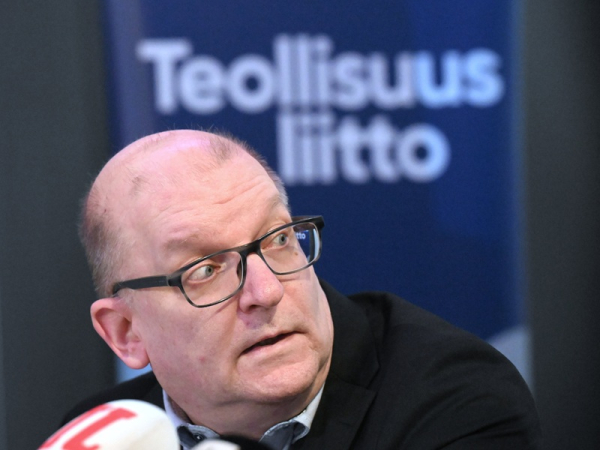
Riku Aalto, the chairperson of the Finnish Industrial Union, reacted at a news conference in Helsinki on Saturday, 22 February 2025. Aalto argued that a pay rise of eight per cent over three years will be enough to offset the erosion of purchasing power caused by inflation in recent years, despite falling well short of the union’s stated goal of raising pay by 10 per cent over two years. (Jussi Nukari – Lehtikuva)
- Next Article Basic social assistance costs rose by nearly 100 million euros
THE BOARDS of the Finnish Industrial Union and Technology Industry Employers of Finland on Saturday showed a green light to the pay agreement their negotiators had accepted on Thursday.
The agreement guarantees employees a pay rise of 2.5 per cent in 2025, 2.9 per cent in 2026 and 2.4 per cent in 2027, equivalent to a pay rise of eight per cent over the three-year agreement term due to the compound interest effect. The third year, though, can be terminated by the contract parties.
An employee currently earning 3,300 euros a month will thus see their earnings rise to 3,383 euros in 2025, to 3,481 euros in 2026 and to 3,564 euros in 2027.
The agreement signals an important breakthrough in what had been a deadlocked labour market situation not only because if directly applies to roughly 90,000 employees in a key export industry, but also because it has an indirect impact on most wage earners in the country. The tradition has been that other industries take their cues from the agreement thrashed out in the technology industry.
Also the Industrial Union and Chemical Industry on Saturday reached an agreement on pay rises – one that has the same structure as the agreement in the technology industry.
The agreements additionally signal the cancellation of the two strikes that had been announced by the Industrial Union for late February and early March.
The Industrial Union, along with other members of the Central Organisation of Finnish Trade Unions (SAK), headed into the round of bargaining talks with the objective of a 10-per-cent pay rise over two years.
The union ultimately fell well short of the objective despite the series of strikes and other industrial actions it had adopted in a bid to apply pressure to its counterpart, a fact its leadership attributed at a news conference to the improving outlook on inflation and increase in global uncertainty. It has also calculated that the eight-per-cent increase is enough to make up for the erosion of purchasing power due to inflation in recent years.
The board did not accept the agreement unanimously, though, with 4 of the 21 members voting against.
“It’s of course true that we didn’t fulfil our objectives, but regardless my estimate is that with these numbers our main goal of making up for the loss of purchasing power will be met by our calculations,” Riku Aalto, the chairperson of the Industrial Union, was quoted as saying at a news conference by YLE.
Technology Industry Employers on Saturday described the pay agreement as “needlessly high,” adding that it is “unfortunately likely” that it will prove costly for the cost competitiveness of technology firms.
“We’ve waited for a return to growth anxiously, but that’s not yet on the horizon. There’s a risk that the economy won’t start growing and then the numbers we agreed on will be too high,” Jarkko Ruohoniemi, the managing director of Technology Industry Employers, stated to YLE. “Industrial peace for three years is a meaningful thing.”
The Industrial Union also succeeded in negotiating provisions that protect its members from legislative amendments, including that the minimum duration of consultative negotiations will not be reduced, that a weighty reason for termination will continue to be required and that local bargaining agreements in the technology industry cannot be made by shop stewards who are not part of the union.
Aleksi Teivainen – HT
- Next Article Basic social assistance costs rose by nearly 100 million euros
Source: www.helsinkitimes.fi
